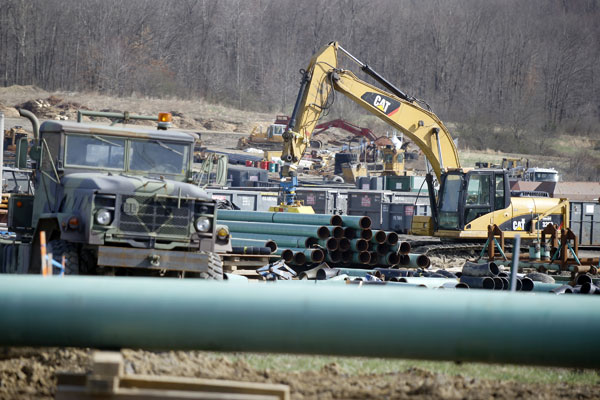A proposal for a nearly $1 billion pipeline that would carry natural gas from Pennsylvania’s shale fields through New Jersey, a bay and the ocean en route to supplying New York City and Long Island faces some key hurdles this week.
New Jersey environmental officials are due to decide Wednesday on several permits for the proposed Northeast Supply Enhancement pipeline.
This is the latest pipeline project to stir emotions in the long-running jobs-versus-the environment debate. Opponents hope a denial will stop the project — even though it survived a similar rejection last month in New York and remains under consideration there.
Williams Companies, the Oklahoma firm planning to spend $926 million on the project, says it is needed to ensure adequate heating and energy supplies to New York City and Long Island, and that it can be built safely with minimal environmental disruption.
Environmental groups and other opponents say the project would stir up tons of highly polluted sediment and reverse decades of hard-won environmental improvements in Raritan Bay, which has been struggling with pollution.
“It could kill the bay,” said Rich Isakson, president of the Belford Seafood Cooperative, a group of Raritan Bay fishermen. “Once you dig up all that stuff, it could take 40 years to settle down again. That’s prime fishing and crabbing grounds they’re going right through.”
The company counters that its construction method would retain “nearly all” of the sediment loosed during the pipe-laying in a trench, and that remaining sediments would stay in the lower half of the water column.
Williams and its customer, the National Grid utility, say the pipeline is needed in order to get the gas to customers. The utility says without the project, it may have to declare a moratorium on gas customer hookups. It is still taking applications from potential new customers but will not process them until after the project is approved, spokeswoman Wendy Ladd said.
“The existing pipeline system currently operates at maximum capacity and is unable to accommodate demand growth driven by fuel oil to natural gas conversions, as well as new development,” Williams spokesman Chris Stockton said.
Opponents say the project would lead to the burning of more fossil fuels, thus contributing to climate change. They also cite a study by 350.org, an anti-fossil fuel group, that claims the demand for natural gas in New York and Long Island is far less than what Williams asserts. The company says part of the demand is from conversions of customers from oil to natural gas.
Some objectors see an ulterior motive in the pipeline project: laying the groundwork for an offshore liquefied natural gas terminal that has repeatedly been rejected in the region on safety and environmental grounds, among others. Such a facility would allow natural gas to be loaded onto ships at sea and exported to other countries.
“This is a Trojan horse,” said Cindy Zipf, executive director of Clean Ocean Action, a New Jersey coastal environmental group. “The real money here is to have an LNG terminal to send that gas to Europe. The billions of dollars that would be possible by building an export facility would just be too enticing.”
Other environmental and fishing groups voiced similar suspicions about a liquefied natural gas terminal eventually being added to the project. Williams says it has no such plans, emphasizing that regulators are evaluating the plan solely for its stated purpose of bringing gas to New York and Long Island.
“There is zero evidence to support the false narrative that this proposal is somehow tied to natural gas exports,” Stockton said. “This pipe will be installed and operated safely, just like the other more than 230 miles of existing pipe and cable that currently safely operate in Raritan Bay.”
The Federal Energy Regulatory Commission approved the project on May 3. On Wednesday, the New Jersey Department of Environmental Protection is to decide on two state permits, one for waterfront development and another for wetlands work. A decision on a separate water quality certification is due June 20.
The agency would not speculate on whether a rejection on any of these permits would be enough to permanently halt the project.
Last month, New York environmental officials rejected the application, saying it violated water quality standards. But the state made its decision “without prejudice,” allowing Williams to reapply, which it did almost immediately.
Jeff Tittel, director of the New Jersey Sierra Club, predicted that even a Department of Environmental decision against the company this week would not permanently halt the proposal.
“We need DEP to stand for ‘Deny Every Pipeline,’” he said. “These pipeline proposals are like Dracula: they keep coming back.”
(AP)












One Response
This pipeline is needed. The use of oil rather than gas results in higher pollution levels which are associated with all kinds of bad health outcomes. And as we build more and more housing for our growing population, the problem will get worse and worse.